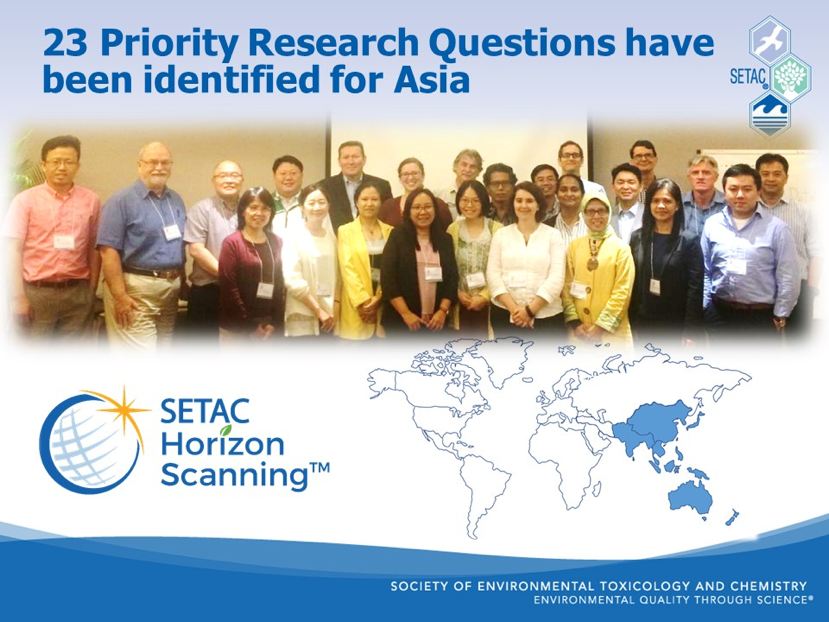参与成员:梁美仪教授
亚洲拥有约46亿人口,占2020年全球78亿人口的一半以上,对自然资源和生态环境构成了巨大压力。联合国预测,到2030年,亚洲将成为全球城市固体废物的主要产生区域。亚洲的空气、土壤和水污染以及食品安全问题一直面对重大挑战。
2015年,环境毒理及化学协会(SETAC)发起「全球前瞻扫描项目」(GHSP),旨在甄别全球最优先的环境质量和健康问题。此前,该项目已在欧洲、拉丁美洲、北美洲和大洋洲进行。最近,亚洲的工作亦已完成,相关出版物已发表。
亚太地区SETAC由500多名从事环境科学、环境工程、环境公共卫生和管理、以及化学品可持续利用的专业成员组成。作为GHSP的一部分,SETAC亚太地区的小组成员应邀提出领域中最重要的研究问题。通过严格社会科学的甄别过程,由亚洲研究人员、政府机构和环保企业领导人组成的一个多学科团队共同确定了亚洲面临的23个优先研究问题,旨在解决这些紧迫的环境质量问题,并实现亚洲的可持续性发展。
这项国际合作研究结果最近于国际学术期刊《Environmental Toxicology and Chemistry》中发表。香港城市大学海洋污染国家重点实验室(SKLMP)主任兼化学系讲座教授梁美仪教授是这项重要工作的领导者之一。梁教授说:「随着亚洲人口和污染问题的日益严重,我们的环境面临着前所未有的挑战,需要通过综合环境政策和创新科技来解决。亚洲GHSP的研究成果将为区内研究人员、资助机构和监管部门提供关键优先研究问题和知识空缺。希望我们的合作研究成果将有助于加快建立切实可行的解决方案,以改善亚洲的环境质量和促进可持续发展。」其他环保专家也分享了梁教授对GHSP工作影响的看法。
GHSP项目的主持者、美国贝勒大学环境科学学院杰出教授Bryan Brooks回应说:「是次国际团队提出的优先环境问题为实现更可持续的环境质量创建了一条及时而重要的研究路线图,这对于我们共同保护人类健康、生物多样性和生态系统服务是必不可少的。」
SETAC全球行政总监 Charles Menzie 博士说:「SETAC为能够支持这个国际项目感到非常自豪。SETAC亚太成员发表的这篇文章非常及时,并为将来的研究提供了方向。我祈望他们的研究成果会转化成切实可行的解决方案,例如环境政策和国际合作等。」
SETAC亚太地区主席、中国暨南大学环境学院游静教授补充说:「当中不少甄选的研究问题针对联合国的可持续发展目标,同时亦有一些问题专门针对亚洲地区的需要。我们的研究工作为解决区域环境问题铺平了道路。我也希望这项倡议能促进更多的国际合作。」
香港城市大学SKLMP前主任、胡梁子慧讲座教授林群声对此国际项目表示祝贺。林教授说:「虽然解决这些优先研究问题并不容易,相信集合国际力量我们能进一步改善亚洲的环境质量,实现更可持续发展。我很高兴我们的SKLMP参与了这一至关重要的工作。」
已发表的文章:
Leung, K.M.Y., Yeung, K.W.Y., You, J., Choi, K.H., Zhang, X.W., Smith, R., Zhou, G.J., Yung, M.M.N., Arias-Barreiro, C., An, Y.J., Burket, S.R., Dwyer, R., Goodkin, N., Hii, Y.S., Hoang, T., Humphrey, C., Iwai, C.B., Jeong, S.W., Juhel, G., Karami, A., Kyriazi-Huber, K., Lee, K.C., Lin, B.L., Lu, B., Martin, P., Nillos, M.G., Oginawati, K., Rathnayake, I.V.N., Risjani, Y., Shoeb, M., Tan, C.H., Tsuchiya, M.C., Ankley, G.T., Boxall, A.B.A., Rudd, M.A., Brooks, B.W. (2020). Towards sustainable environmental quality: Priority research questions for Asia. Environmental Toxicology and Chemistry, 39(8), 1485-1505. Link to the article: https://setac.onlinelibrary.wiley.com/doi/full/10.1002/etc.4788
| Table 1: The 23 priority questions identified by the Asian GHSP among four themes. | |
| 1 | How do we develop broad screen analytical methods integrating non-target directed analysis for identifying key chemical stressors responsible for observed toxicity? |
| 2 | How do we develop methods to identify and quantify nano- and microplastics in different environmental compartments (water, sediment, soil, biota) associated with potential toxicity or interactions with other contaminants? |
| 3 | What are the terrestrial and aquatic risks of atmospheric contaminants in Asia? |
| 4 | How can we improve methods to classify, identify and separate nano-materials contaminants from their bulk counterparts and differentiate effects caused by nano-materials in the environment? |
| 5 | How can we better use field data and incorporate new big data (e.g., ecological genome) approaches for improving ecological risk assessments and decision making? |
| 6 | How can we develop and advance laboratory (e.g., in vitro, in vivo, analytical) and theoretical (toxicokinetic, toxicodynamic) approaches to understand (prospective, retrospective) adverse outcomes of complex chemical mixtures (e.g., pesticides, surfactants, medicines, metals)? |
| 7 | How we can improve the current approaches to assess and manage risks of micro-pollutants and emerging contaminants? |
| 8 | How can we integrate high throughput screening with next generation computational toxicology tools to support hazard and risk assessment of individual chemicals and complex mixtures? |
| 9 | How can we develop advanced biological tools to better understand and predict toxic mechanisms and interactions across species in multiple highly biodiverse compartments for risk assessment and management of chemical contaminants in Asia? |
| 10 | How can we analyse big data and develop effective risk communication approaches (e.g., report card system, real-time reporting) for environmental status (e.g., ecosystem functions and services)? |
| 11 | How can we use new developments in nanoscience and nanotechnology to advance ecotoxicological research? |
| 12 | How can we strengthen the environmental quality criteria system (e.g., water, sediment, soil, air) to adequately protect ecosystems that are experiencing multiple stressors and changing climate? |
| 13 | What are the influences of changing landscapes and climate change on the resilience of terrestrial and aquatic ecosystems, and how do we measure the ecological endpoints with reference to chemical pollution? |
| 14 | How can we develop an integrative and effective framework (e.g., environmental policy, green technologies) to manage nutrient loading and associated hypoxia in Asia? |
| 15 | How will changes to physicochemical characteristics (e.g., salinization/ion imbalance, pH, temperature, hypoxia due to enrichment) alter bioavailability and effects of chemical stressors in the environment? |
| 16 | How can we prioritize and apportion chemical stressors in complex scenarios to guide restoration efforts? |
| 17 | How can we identify adverse impacts of multiple stressors in the field to biodiversity (including multigenerational, evolutionary, and developmental), ecosystem services, and human health? |
| 18 | To what extent is seawater pH in South-East Asia impacted by terrestrial inputs (e.g., organic carbon, nutrients, other anthropogenic sources such as mining), how are these inputs changing due to human activities (including CO2), and how does this affect vulnerable coastal ecosystems such as coral reefs? |
| 19 | How can we develop new technology and promote green chemistry for enhancing reuse of waste and preventing environmental impacts? |
| 20 | Given increasing population growth and per capita demand for seafood in Asia, how can we develop sustainable aquaculture practices while protecting environmental quality, particularly in coastal waters? |
| 21 | How can we develop innovative solid waste management programs to protect environmental quality, particularly in rural areas of less developed regions in Asia? |
| 22 | What is the extent of antibiotic pollution in the environment and associated risks of antibiotic resistance in rural and urban regions of Asia? |
| 23 |
How can we develop sustainable development frameworks (e.g., green chemistry) to address, balance and manage the production (e.g., food production, forestry) and protection of ecosystem services? |
Image 1: A multidisciplinary team of Asian researchers, government agencies and businesses leaders
jointly identified 23 priority research questions for Asia via the GHSP
